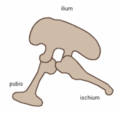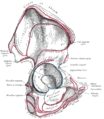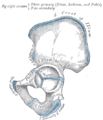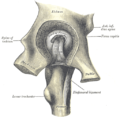- Ilium (bone)
-
For other uses, see Ilion (disambiguation).For other uses, see Ilia (disambiguation)."Illia" redirects here. For the president of Argentina, see Arturo Umberto Illia.Not to be confused with Ileum.
Bone: Ilium of pelvis Overview of Ilium as largest bone of the pelvis. Capsule of hip-joint (distended). Posterior aspect. (Ilium labeled at top.) Latin os ilii Gray's subject #57 236 MeSH Ilium The ilium is the uppermost and largest bone of the pelvis, and appears in most vertebrates including mammals and birds, but not bony fish. All reptiles have an ilium except snakes, although some snake species have a tiny bone which is considered to be an ilium.[1]
The name comes from the Latin (ile, ilis), meaning "groin" or "flank."[2]
The ilium of the human is divisible into two parts, the body and the ala; the separation is indicated on the top surface by a curved line, the arcuate line, and on the external surface by the margin of the acetabulum.
Contents
Body (corpus oss. ilii)
The body enters into the formation of the acetabulum, of which it forms rather less than two-fifths.
Its external surface is partly articular, partly non-articular; the articular segment forms part of the lunate surface of the acetabulum, the non-articular portion contributes to the acetabular fossa.
The internal surface of the body is part of the wall of the lesser pelvis and gives origin to some fibers of the Obturator internus.
Below, it is continuous with the pelvic surfaces of the ischium and pubis, only a faint line indicating the place of union.
Ala (ala oss. ilii)
Further information: Wing of iliumThe wing of ilium (or ala) is the large expanded portion which bounds the greater pelvis laterally. It presents for examination two surfaces—an external and an internal—a crest, and two borders—an anterior and a posterior.
Biiliac width
In humans, biiliac width is an anatomical term referring to the widest measure of the pelvis between the outer edges of the upper iliac bones.
Biiliac width has the following common synonyms: pelvic bone width, biiliac breadth, intercristal breadth/width, bi-iliac breadth/width and biiliocristal breadth/width.
In the average adult female, it measures 28 cm (11 in).[citation needed] It is best measured by anthropometric calipers (an anthropometer designed for such measurement is called a pelvimeter). Attempting to measure biiliac width with a tape measure along a curved surface is inaccurate.
The biiliac width measure is helpful in obstetrics because a pelvis that is significantly too small or too large can have obstetrical complications. For example, a large baby or a small pelvis often lead to death unless a caesarean section is performed. [3]
It is also used by anthropologists to estimate body mass.[4]
In dinosaurs
The clade Dinosauria is divided into the Saurischia and Ornithischia based on hip structure, including importantly that of the ilium.[5]
See also
Additional images
References
- ^ Jacobson, Elliott R. (2007). Infectious Diseases and Pathology of Reptiles. CRC Press. p. 7. ISBN 0849323215, 9780849323218. http://books.google.com/?id=hhO4WAZcVLEC&pg=PA7&lpg=PA7&dq=%22ilium%22+%22in+snakes%22. Retrieved 2009-01-09.
- ^ Taber, Clarence Wilbur; Venes, Donald (2005). Taber's cyclopedic medical dictionary. Philadelphia: F.A. Davis. ISBN 0-8036-1207-9.
- ^ "Encyclopedia of Medicine: Cesarean Section". eNotes. http://health.enotes.com/medicine-encyclopedia/cesarean-section.
- ^ Ruff C, Niskanenb M, Junnob J, Jamisonc P (2005). "Body mass prediction from stature and bi-iliac breadth in two high latitude populations, with application to earlier higher latitude humans". Journal of Human Evolution 48 (4): 381–392. doi:10.1016/j.jhevol.2004.11.009. PMID 15788184. http://www.hopkinsmedicine.org/FAE/CBRMNJAPJ2005JHE.pdf. Retrieved 2006-07-26.
- ^ Seeley, H.G. (1888). "On the classification of the fossil animals commonly named Dinosauria." Proceedings of the Royal Society of London, 43: 165-171.
External links
- SUNY Labs 44:st-0701
- pelvis at The Anatomy Lesson by Wesley Norman (Georgetown University)
This article was originally based on an entry from a public domain edition of Gray's Anatomy. As such, some of the information contained within it may be outdated.
Bones of pelvis / pelvic cavity (TA A02.5.01–03, GA 2.231–241) General Ilium arcuate linegluteal lines (posterior, anterior, inferior)
iliac spines (anterior superior, anterior inferior, posterior superior, posterior inferior)
other: crest · tuberosity · tubercle · fossaIschium no substructuresPubis Compound Categories:- Musculoskeletal system stubs
- Pelvis
Wikimedia Foundation. 2010.












